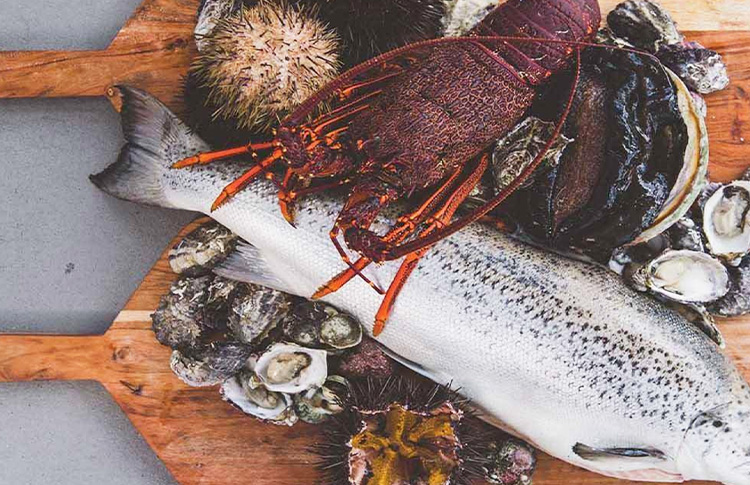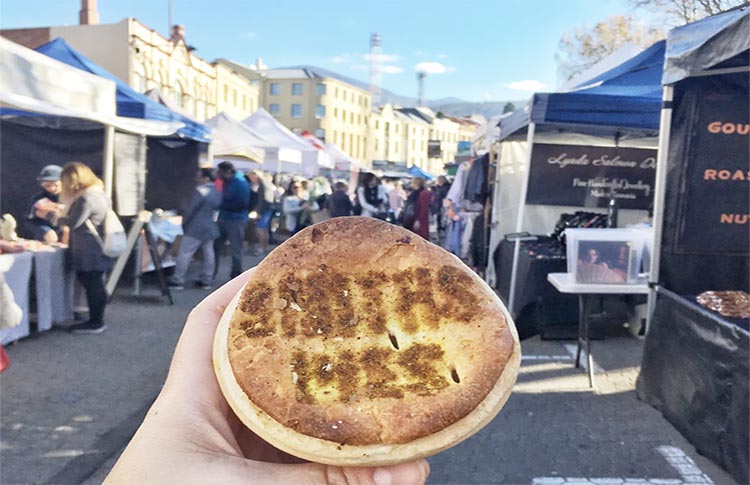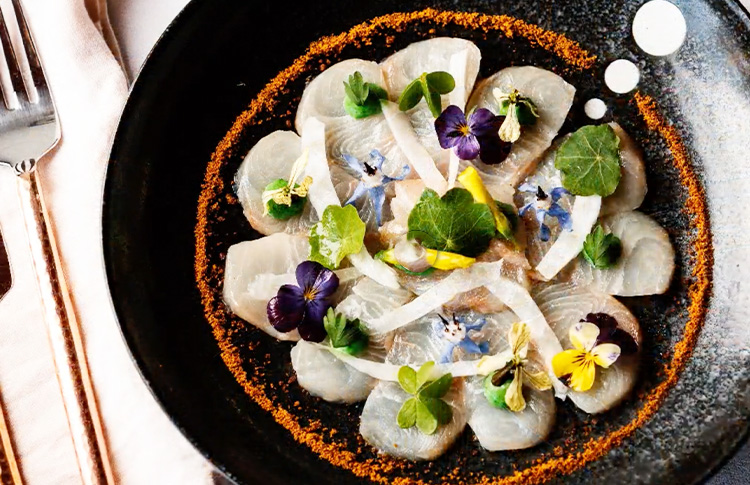
Tasmanian seafood is renowned around Australia and the world. Find out why by following this guide to getting the best Tasmanian seafood straight from the source.

This guide aims to give you a quick but comprehensive rundown on what seafood to expect to try when you visit Tasmania, and how to find your way to the best of it.
In this guide we will answer the following questions:
Which seafood is Tasmania known for?
Is Tasmanian seafood sustainable?
Can you buy fresh local seafood in Tasmania?
Where can you eat the best seafood in Tasmania?

To start with, let’s clear up the Tasmanian seafoods that you probably (or probably should) have already heard about:
What seafood is Tasmania famous for?
Scallops
The Tasmanian scallop fishery is not as old as some of Tassie’s other shellfish industries or customary traditions (see abalone and oysters, below), but it has arguably become its most iconic for one major reason: the scallop pie. Distinctly, uniquely Tasmanian, scallop pies date back to the 1800s and are arguably the state’s national dish. They feature plump, local scallops cooked in a creamy, curry sauce, wrapped in high layers of puff pastry. They can be found at many bakeries and seaside stalls around the island, and are best eaten during scallop season (April-July) to avoid getting a not-quite-as-delicious, frozen-scallop version. You can, of course, also enjoy fresh Tasmanian scallops in other, equally delicious ways.
Where to try it: Jackman & McRoss is Hobart’s most famous scallop pie, situated right beside Salamanca Market. For a special trip, though, head to Bakery 31 in Ross (between Launceston and Hobart in the Midlands) or Oliver's Bakery in Burnie, on the East Coast.
Abalone
Tasmania’s cool, pristine waters are widely regarded as providing the ideal habitat for both blacklip and greenlip abalone, a meaty, bottom-dwelling type of shellfish renowned for having a naturally rich, buttery taste – as well as for being among the world’s most expensive types of seafood. Their taste, value and nutritional quality has been recognised by local Aboriginal peoples for thousands of years, and they have long been a popular target for recreational divers in Tasmania. The abalone fishery is one of few in Australia for which indigenous groups are given specific cultural rights to fish abalone commercially, although traditional diving and harvesting methods have been supplemented by abalone farms in recent decades (largely in order to protect natural habitat levels from overharvesting). Try it whole, sliced thin, cooked in kelp, or in traditionally dried or smoked form.
Where to try it: Candy Abalone, in Hobart, for their famous naturally-dried abalone; Tas Live Abalone in Mornington, for a factory tour and tasting; Tasmanian Abalone’s JST Abalone farm in Stanley, in the northwest, for straight-from-the-source abalone; or Hobart’s iconic Mures Upper Deck restaurant on the Waterfront, for their superb abalone dishes.

Oysters
Another Tasmanian shellfish with an ancient history, native angasi oysters had been harvested by indigenous Tasmanian peoples for thousands of years before Europeans arrived in the 1800s. However, the destructive, unsustainable technique of dredging was also brought in with the Europeans, and the angasi oyster was pushed to the brink of extinction, and it hasn’t been a commercially available species for most of the past century. Although there are signs that a sustainable form of angasi oyster fishery might be on the horizon (farmed, rather than wild harvested), it is still the introduced Pacific oyster that is most commonly eaten (and celebrated) around Tasmania and beyond. Despite their shorter history in Tasmania, these oysters have taken to the pristine climate and waters just as well, and Tasmanian oysters’ taste and reputation speak for themselves.
Where to eat it: The playful Melshell Oyster Shack and impressive Freycinet Marine Farm are must-visit options for oyster-lovers on the way to Freycinet National Park on the East Coast. If you’re heading south to Bruny Island, don’t pass by Get Shucked Oysters on your way through Great Bay. If you’re staying close to Hobart, be sure to visit Barilla Bay Oyster Farm, not far from the airport in Cambridge.
Lobster
The quality of native southern rock lobster has rightfully earned Tasmania its reputation (alongside New Zealand and the Chatham Islands) as the best place to eat crayfish in the South Pacific. The season for both recreational and commercial lobster harvesting is strictly limited to a few months over summer (November-April), ensuring a largely sustainable fishery for Tasmanian lobster. Flinders Island lobster is undoubtedly the most famous and most revered in Tasmania, and it hosts a popular Food and Crayfish Festival every April.
Where to eat it: Outside of the Flinders Island Crayfish Festival, the Lobster Shack in Bicheno, on the East Coast, is the best place to try Tasmanian lobster, combining beautiful fresh crayfish with stunning waterfront views.

Fin fish
Of course, Tasmania isn’t only about shellfish and crustaceans, and Tasmania’s waters are also home to a large number of popular white fish and fin fish. The popularity of many preferred local species grew out of a strong local recreational fishery – especially regarding sand flathead (a firm-fleshed, bottom-dwelling fish found abundantly in shallow Tasmanian waters, often served simply grilled or pan-fried with the skin on). Likewise, leatherjacket is a popular recreational and commercial species that holds its shape well in everything from curries and stews to barbecue grills. Blue eye trevalla is another famous local Tasmanian specialty, caught in the deeper waters towards Antarctica, and popular on pub menus and restaurant boards across the state.
Salmon has only appeared in Tasmanian waters in recent decades (since the 1980s), and the way it is currently intensively farmed makes it an unhealthy choice for many reasons. Hopefully this situation improves in the future, and with well-run inland salmon farms, Tasmanian salmon may live up to the lofty reputation it has already attained. (If you are still curious about trying or learning more about salmon while in Tasmania, you can read more about the Tasmanian salmon situation in FLT’s Tasmanian Salmon Guide or the blog post dedicated to Famous Foods in Tasmania).
Where can you buy the best fresh seafood in Tasmania?
If you want to transfer all that information into fresh seafood, and prefer cooking it yourself than picking it up at one of the spots mentioned above, then read on for some recommendations on where to go.
Both Launceston and Hobart have their fair share of impressive seafood restaurants. Unsurprisingly, however, many of the best places to taste fresh seafood in Tasmania are a bit further off the beaten track: in small fishing villages and coastal settlements dotted around the island(s).
Here are some recommended places to look for the latest, freshest catch around Tasmania:
The North Coast and the Northwest
- Stanley Seafood Sales (Stanley)
- Petuna Seafoods (Devonport)
- Straight Off the Boat (Devonport)
- Food on Merino (Launceston)
- Kyeema Seafoods (Launceston)
The East Coast
- Spring Bay Seafoods (Triabunna)
- Tasmanian Coastal Seafoods (Bicheno)
- Freycinet Marine Farm (Coles Bay)
- The Lobster Shack (Bicheno)
- The Fish Van (Triabunna)
Hobart and Southern Tasmania
- Constitution Dock Fresh Fish (Hobart Waterfront)
- Mures Lower Deck (Hobart Waterfront)
- The Fish Man (Hobart Waterfront)
- Ashmore Foods (Mornington)
- Island Markets (Moonah)
Planning a trip to Tasmania?
If you’re ready to start tasting some Tasmanian seafood straight off the boat, or to start planning a Tasmanian holiday more broadly, then take a look at First Light Travel’s page dedicated to several topics covering what to expect in Tasmania (including the best places to eat seafood in Launceston and Hobart). They also have a number of Tasmanian holiday tour itineraries to browse.
Contact FLT’s expert Tasmanian travel staff directly to discuss organising your own, personalised itinerary, free of charge.
Recent Posts
Blog Categories
Blog archives
- March 2025 (1)
- November 2024 (1)
- October 2024 (1)
- September 2024 (8)
- June 2024 (4)
- May 2024 (2)
- April 2024 (2)
- March 2024 (13)
- February 2024 (3)
- January 2024 (5)
- December 2023 (6)
- November 2023 (4)
- October 2023 (11)
- September 2023 (2)
- August 2023 (6)
- July 2023 (2)
- June 2023 (17)
- May 2023 (3)
- April 2023 (5)
- March 2023 (8)
- February 2023 (9)
- January 2023 (12)
- December 2022 (9)
- November 2022 (12)
- October 2022 (12)
- September 2022 (12)
- August 2022 (6)
- July 2022 (9)
- June 2022 (7)
- May 2022 (3)
- April 2022 (4)
- March 2022 (6)
- February 2022 (1)
- January 2022 (4)
- December 2021 (2)
- November 2021 (3)
- October 2021 (1)
- September 2021 (4)
- August 2021 (10)
- July 2021 (13)
- June 2021 (6)
- April 2021 (2)
- March 2021 (2)
- February 2021 (1)
- January 2021 (1)
- December 2020 (2)
- November 2020 (3)
- October 2020 (2)
- September 2020 (1)
- August 2020 (1)
- July 2020 (1)
- June 2020 (1)
- May 2020 (1)
- March 2020 (1)
- February 2020 (2)
- January 2020 (4)
- December 2019 (2)
- November 2019 (1)
- October 2019 (1)
- September 2019 (5)
- August 2019 (1)
- July 2019 (5)
- June 2019 (1)
- May 2019 (1)
- April 2019 (1)
- March 2019 (1)
- February 2019 (1)
- January 2019 (1)
- December 2018 (1)
- October 2018 (1)
- May 2018 (1)
- February 2018 (1)
- December 2017 (1)
- October 2017 (1)
- June 2017 (1)
- May 2017 (1)
- February 2017 (1)
- January 2017 (1)
- September 2016 (1)
- August 2016 (2)
- July 2016 (1)
- June 2016 (1)
- May 2016 (1)
- April 2016 (1)
- December 2015 (1)



